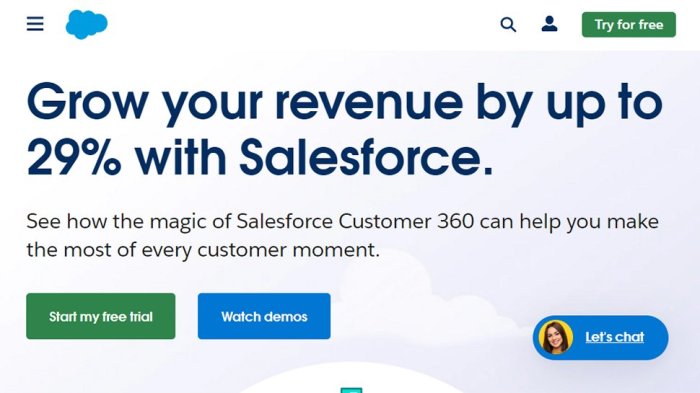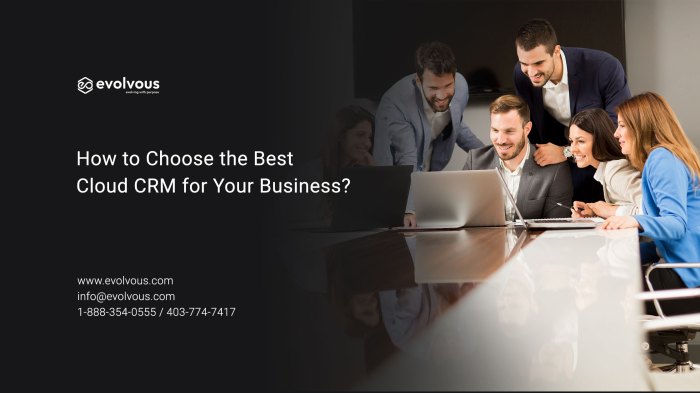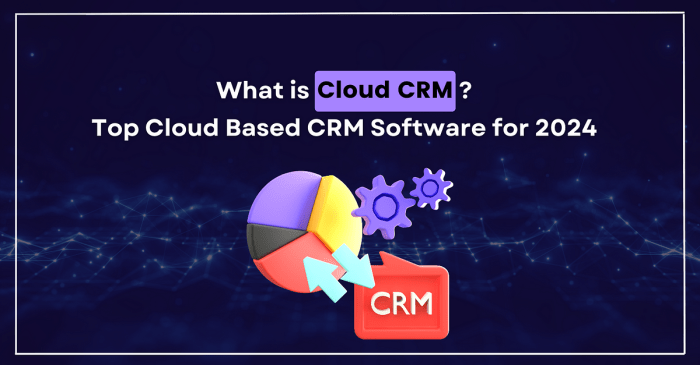Best cloud-based CRM software offers businesses a powerful way to manage customer relationships, streamline operations, and boost sales. This comprehensive guide explores the key features, leading providers, security considerations, and future trends of cloud-based CRM solutions, helping you make an informed decision for your organization’s needs. We’ll delve into the critical factors to consider when choosing a system, examining everything from scalability and integration capabilities to data privacy and security protocols.
From understanding the nuances of different pricing models to navigating the complexities of implementation and integration, we aim to provide a clear and concise overview of the cloud-based CRM landscape. This guide will empower you to select the best software to meet your specific requirements, optimizing your customer interactions and driving business growth.
Defining “Best” in Cloud-Based CRM Software
Choosing the “best” cloud-based CRM software depends heavily on individual business needs and priorities. There’s no one-size-fits-all solution. Several key criteria consistently influence user decisions.
Key Criteria for Cloud-Based CRM Selection, Best cloud-based CRM software
Five crucial factors users consider when choosing a cloud-based CRM include: scalability and flexibility to accommodate growth, seamless integration with existing business tools, a user-friendly interface that ensures ease of adoption, robust security features to protect sensitive data, and a pricing model that aligns with the budget. These aspects collectively determine the software’s overall value and effectiveness.
Scalability and Flexibility in Cloud CRM
Scalability and flexibility are paramount in a cloud CRM. Scalability ensures the system can handle increasing data volumes and user numbers as the business expands, without requiring significant infrastructural changes. Flexibility allows for customization and adaptation to evolving business processes, integrating new features or modules as needed. A rigid, inflexible system will quickly become a bottleneck.
Integration Capabilities with Other Business Tools
A cloud CRM’s value significantly increases with its ability to integrate with other business tools like marketing automation platforms, accounting software, and e-commerce systems. This integration streamlines workflows, eliminates data silos, and provides a unified view of customer interactions across all channels. Without robust integration, data remains fragmented, hindering efficient operations.
On-Premise vs. Cloud-Based CRM: A Comparison
On-premise CRM systems require significant upfront investment in hardware and IT infrastructure, along with ongoing maintenance costs. Cloud-based CRMs offer a more cost-effective, scalable, and accessible alternative. On-premise systems offer greater control over data security, while cloud solutions often benefit from the vendor’s expertise in security management. The choice depends on the organization’s IT capabilities and risk tolerance.
Cloud CRM Pricing Models
| Provider | Pricing Model | Features Included | Typical Cost per User/Month |
|---|---|---|---|
| Salesforce Sales Cloud | Tiered subscription | Sales force automation, contact management, reporting | $25 – $300+ |
| HubSpot CRM | Freemium | Basic CRM features, contact management, email marketing | Free – $1200+ |
| Microsoft Dynamics 365 | Tiered subscription | Sales, marketing, customer service, and operations modules | $65 – $200+ |
| Zoho CRM | Tiered subscription | Sales force automation, contact management, marketing automation | $14 – $50+ |
Top Cloud-Based CRM Features
Cloud-based CRMs offer a wide range of functionalities designed to enhance customer interactions and streamline business processes. These features are crucial for driving sales growth, improving customer service, and making data-driven decisions.
Customer Relationship Management (CRM) Functionalities
Core CRM functionalities include contact management (organizing and tracking customer information), sales force automation (automating sales tasks), marketing automation (automating marketing campaigns), and customer service management (managing customer interactions and resolving issues). These functions work together to provide a holistic view of the customer journey.
Automation Features for Improved Efficiency

Automation features, such as automated email sequences, lead scoring, and workflow automation, significantly improve sales and marketing efficiency. For instance, automated email sequences nurture leads, while lead scoring prioritizes high-potential prospects, allowing sales teams to focus their efforts effectively. Workflow automation streamlines repetitive tasks, freeing up time for more strategic activities.
Reporting and Analytics Dashboards for Strategic Decision-Making
Reporting and analytics dashboards provide valuable insights into customer behavior, sales performance, and marketing campaign effectiveness. These dashboards enable data-driven decision-making, allowing businesses to identify areas for improvement, optimize strategies, and achieve better outcomes. Real-time data visualization empowers proactive adjustments to business strategies.
Mobile Accessibility for Sales Teams and Customer Service
Mobile accessibility allows sales teams and customer service representatives to access CRM data and functionalities from anywhere, anytime. This improves responsiveness, enabling quick issue resolution and enhanced customer engagement. Immediate access to customer information empowers representatives to provide personalized service.
Illustrative Customer Journey Flowchart within a Cloud-Based CRM
A typical customer journey within a cloud-based CRM might start with lead capture (e.g., through a website form), followed by lead nurturing (automated email sequences), qualification (lead scoring), sales engagement (personalized communication), conversion (closing the deal), and ongoing relationship management (post-sale support). Each stage is documented and tracked within the system. The flowchart visually represents this sequential process.
Leading Cloud-Based CRM Providers

Several leading cloud-based CRM providers cater to diverse business needs and sizes. Choosing the right provider depends on specific requirements and budget constraints.
Comparison of Three Leading Cloud-Based CRM Providers
Salesforce, HubSpot, and Microsoft Dynamics 365 are three prominent providers, each targeting different market segments. Salesforce focuses on large enterprises, HubSpot on small to medium-sized businesses (SMBs), and Microsoft Dynamics 365 on a broad range of businesses, integrating well with other Microsoft products.
Five Prominent Cloud-Based CRM Platforms and Key Differentiators
- Salesforce Sales Cloud: Comprehensive features, robust scalability, extensive customization options.
- HubSpot CRM: User-friendly interface, strong marketing automation capabilities, freemium model.
- Microsoft Dynamics 365: Seamless integration with other Microsoft products, enterprise-grade features, strong customer support.
- Zoho CRM: Affordable pricing, wide range of features, suitable for small to medium-sized businesses.
- SAP CRM: Powerful enterprise-level solution, strong integration with SAP ecosystem.
Unique Selling Propositions of Three CRM Vendors
Salesforce’s strength lies in its comprehensive ecosystem and extensive app marketplace. HubSpot excels in its inbound marketing focus and user-friendly interface. Microsoft Dynamics 365 offers seamless integration with the Microsoft Office suite, appealing to businesses already invested in the Microsoft ecosystem.
Open-Source vs. Proprietary Cloud CRM Solutions
Open-source CRMs offer flexibility and customization but may require significant technical expertise for implementation and maintenance. Proprietary solutions offer better support and security but may be less flexible and more expensive. The choice depends on the organization’s technical capabilities and budget.
Pros and Cons of Three Leading Providers
- Salesforce:
- Pros: Extensive features, scalability, strong ecosystem.
- Cons: High cost, complex interface, steep learning curve.
- HubSpot:
- Pros: User-friendly, strong marketing automation, freemium model.
- Cons: Limited customization options, may lack advanced features for large enterprises.
- Microsoft Dynamics 365:
- Pros: Seamless Microsoft integration, enterprise-grade features, robust support.
- Cons: Can be expensive, complex implementation, may require significant training.
Security and Data Privacy in Cloud-Based CRM: Best Cloud-based CRM Software
Security and data privacy are critical considerations when choosing a cloud-based CRM. Robust security measures are essential to protect sensitive customer data from unauthorized access and breaches.
Data Encryption and Access Control in Cloud-Based CRM Security
Data encryption protects data in transit and at rest, while access control restricts access to authorized personnel only. Multi-factor authentication adds an extra layer of security, preventing unauthorized access even if credentials are compromised. These measures are fundamental for maintaining data confidentiality.
Compliance with Data Privacy Regulations
Compliance with regulations like GDPR (General Data Protection Regulation) and CCPA (California Consumer Privacy Act) is crucial. Choosing a CRM provider that demonstrates compliance with these regulations ensures adherence to legal requirements and protects customer data. Non-compliance can lead to significant penalties.
Vendor Security Certifications and Audits
Vendor security certifications (e.g., ISO 27001) and regular security audits demonstrate a commitment to data protection. These certifications provide assurance that the provider has implemented robust security measures to protect user data. Verifying these credentials is a crucial step in due diligence.
Security Measures Implemented by Cloud CRM Providers
Cloud CRM providers typically implement various security measures, including data encryption, access control, intrusion detection systems, and regular security audits. They also employ firewalls and other network security protocols to protect against cyber threats. The specific measures vary depending on the provider.
Best Practices for Securing Data within a Cloud-Based CRM
Best practices include regularly updating passwords, enabling multi-factor authentication, restricting user access based on roles and responsibilities, and regularly backing up data. Employee training on security best practices is also crucial to prevent human error. Proactive monitoring for suspicious activities is also essential.
Implementation and Integration of Cloud-Based CRM
Successfully implementing a cloud-based CRM involves careful planning, data migration, integration with other systems, user training, and ongoing support.
Migrating Data from an Existing System
Data migration involves extracting data from the existing system, cleaning and transforming it to fit the new CRM’s structure, and uploading it to the cloud-based CRM. This process requires careful planning and execution to minimize data loss and ensure data integrity. Thorough testing is essential before the complete migration.
Challenges of Integrating a Cloud-Based CRM
Integrating a cloud-based CRM with other business applications can present challenges, including data mapping inconsistencies, API limitations, and potential conflicts between systems. Careful planning and the use of integration tools can help mitigate these challenges. Understanding the APIs of all involved systems is crucial.
Importance of User Training and Ongoing Support

User training is essential to ensure users understand how to effectively utilize the CRM system. Ongoing support helps address issues and provides assistance as needed. Adequate training and support are key to maximizing the CRM’s effectiveness and user adoption. Effective training programs should include both theoretical and practical elements.
Managing User Access and Permissions
Managing user access and permissions ensures that only authorized personnel can access sensitive data. Role-based access control (RBAC) is a common approach to managing permissions, ensuring that users only have access to the data and functionalities they need to perform their jobs. Regular review of permissions is also recommended.
Step-by-Step Guide to Implementing a Cloud-Based CRM
1. Needs Assessment
Define business requirements and objectives.
2. Vendor Selection
Choose a CRM provider that meets the needs.
3. Data Migration
Migrate data from existing systems.
4. System Configuration
Configure the CRM to match business processes.
5. User Training
Train users on the system’s functionalities.
6. Integration
Integrate with other business applications.
7. Go-Live
Launch the CRM system.
8. Monitoring and Optimization
Continuously monitor and optimize performance.
Future Trends in Cloud-Based CRM Software
The cloud-based CRM landscape is constantly evolving, driven by technological advancements and changing business needs.
Emerging Trends Shaping the Future of Cloud-Based CRM
Three key trends are the increasing adoption of AI-powered functionalities, the growing importance of predictive analytics, and the evolution of CRM user interfaces towards more intuitive and personalized experiences. These trends are reshaping how businesses interact with their customers.
Impact of Artificial Intelligence (AI) on CRM Functionalities
AI is transforming CRM functionalities by automating tasks, providing intelligent insights, and personalizing customer interactions. AI-powered chatbots can handle customer inquiries, while predictive analytics can forecast sales and identify at-risk customers. AI is improving efficiency and customer satisfaction.
Role of Predictive Analytics in Improving Sales Forecasting and Customer Engagement
Predictive analytics uses historical data and machine learning algorithms to predict future outcomes, such as sales forecasts and customer churn. This enables proactive interventions, allowing businesses to optimize sales strategies and improve customer retention. Predictive models can identify high-potential leads and personalize marketing campaigns.
Examples of Cloud-Based CRM Use in Different Industries
Cloud-based CRMs are used across various industries, from retail (managing customer loyalty programs) to healthcare (managing patient records) to finance (managing customer accounts). The specific applications vary depending on the industry’s needs, but the core functionalities remain consistent.
Anticipated Evolution of CRM User Interfaces
In the next five years, CRM user interfaces are expected to become more intuitive, personalized, and mobile-friendly. Voice-activated interfaces and augmented reality features could further enhance user experience, making CRM systems more accessible and user-friendly. The focus will be on simplification and ease of use.
Final Conclusion
Selecting the best cloud-based CRM software requires careful consideration of various factors, from functionality and scalability to security and integration capabilities. By understanding your business needs, evaluating leading providers, and prioritizing data security, you can confidently choose a solution that streamlines your operations, enhances customer relationships, and drives sustainable growth. Remember to factor in ongoing support, user training, and future scalability when making your final decision.
The right CRM can significantly improve your business efficiency and profitability.
FAQ Summary
What is the average cost of cloud-based CRM software?
Pricing varies greatly depending on features, number of users, and provider. Expect to find options ranging from free plans with limited functionality to enterprise solutions costing thousands per month.
How long does it typically take to implement a cloud-based CRM?
Implementation time depends on the complexity of the system, data migration needs, and user training requirements. It can range from a few weeks to several months.
What are the key security risks associated with cloud-based CRM?
Key risks include data breaches, unauthorized access, and loss of data due to system failures. Choosing a reputable provider with strong security measures is crucial.
Can I integrate my existing accounting software with a cloud-based CRM?
Many cloud-based CRMs offer integrations with popular accounting software through APIs or third-party apps. Check the provider’s documentation for compatibility.
